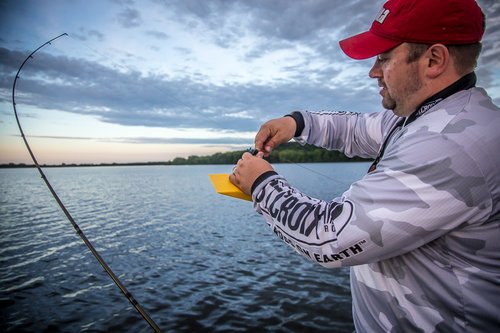Photo Credit - Matt Addington
My initial forays into leadcore for walleyes were pretty basic. Start with a full-core (10 color) setup, drop back a crankbait until it “ticked” bottom occasionally, and wait for a walleye or sauger to pull on the other end. The more I used it however, the more advantages I saw it present for all kinds of situations. Lessons learned from numerous salmon and trout charter captains helped shape the way I think of it for walleyes no matter where I fish. From deep clear water lakes, to even shallow river situations, there’s much more you can do with a leadcore setup than the old drop-back-and-drag.
I think the first key to fine-tuning different approaches with lead line is to fully realize where it excels, and where it does not. By its construction and very nature, leadcore fishing involves trolling, and is best utilized for pulling at consistent depths. The string of lead running through that tube of braided line serves a single purpose, and that’s to sink, such that letting out more means more depth and vice versa. Hairpin trolling runs along tight, variable breaks are challenging and only encouraged where leadcore fishing presents the last or best means to offer baits to fish. Another key for taking this technique further is to realize that sinking line doesn’t always mean sinking to the lake or river bottom. Here are my top methods for extending leadcore beyond simple back-of-the-boat trolling:
Segmented Leadcore
It’s likely you’ve heard of open basin trolling, where suspended walleyes chasing Tullibee are targeted by imitator crankbaits at the depths of fish gorging on bait. Segmented leadcore, or a finite number of colors of lead line spooled to backing, is a primary driver for the technique. For example, a 3-color segmented leadcore setup simply means 3 colors of lead, then backing are spooled to the reel. Charter captains that utilize leadcore for salmon fishing often have 2 rods (one for each side of the boat) rigged with 3, 4, 5, 7 or other numbers of colors per reel each. This is with the idea that a specific rod/reel combination will serve a separate portion of the water column, no matter where you want to reach. For walleye anglers, quite often I recommend having a 3-color segmented leadcore setup. This is simply achieved by spooling up your backing, then 3 colors of lead.
Remember that the driver behind this is depth, and if you’re using Sufix Advanced Leadcore, your dive is 7-feet per color, and various forms of standard leadcore 5-feet per color when trolling around 2mph. Pull faster, and you raise approximately 1 foot for every 0.2 mph in speed, pull slower, the same is true in reverse. From there, add the depth of your crankbait depending on the length of your leader. Long leaders make for a truer dive depth as advertised on the package. Shorter leader lengths in the 6 foot or so category, and you’re only going to get an additional foot or two of dive. For example, if I’m running a #5 Shad Rap on 3 colors of Advanced leadcore at 2.2 mph with a 6 foot fluorocarbon leader, my math would be as follows:
(7’ per color X 3 colors) + (2 foot crankbait diving depth) – (1 foot for 0.2mph speed increase) = ~22FOW
If that math is confusing, try breaking down each step that contributes to dive or rise. If it’s still confusing, there’s an app for that. It’s called the Leadcore Depth Calculator on Android/IOS and is pretty handy. From there, even if you’re confused, get out and pull it around. Depth is relative, and if you find success, repeat, repeat, repeat.
Planer Boards
Salmon and trout guys will tell you that their biggest fish often come on the outside “boards,” which is no surprise in clear water given that often these fish are less than 50 feet down in ultra-clear water where the boat will spook fish. Walleye anglers should pay attention, as the same is often true when pulling segmented leadcore in open-basin situations.
Attach planer boards above leadcore a few feet on the backing to avoid ruining the lead inside your line, and cover various depths via your 3-color, 4-color, or more segmented leadcore rods. Let your electronics tell you where you’re seeing feeding walleyes with schools of bait, then target those depths above, at, and below the same level as the fish. Use planer boards to maximize the number of rods you can legally use by spreading out baits and putting them further away from the boat.
Other Wrinkles
Tourney pros long ago learned to run leadcore in shallow water where it was murky or turbid enough to get away with it. The benefit being that they could run 2 leadcore setups almost as if they were downrigger balls, directly behind and below the boat with very little line out. This freed them up to run more traditional mono or braid long-line trolling applications further back behind the boat where more rods were legal, such that they could run 4 or more setups without anything tangling. The leadcore is pinned directly behind the boat, and the other setups need to be back 100-150’ or more to achieve depth.
Many anglers run spinners and bait on leadcore as well, while again remembering that this technique is all about getting your presentation to a specific depth. Leadcore achieves that objective and then some, with many anglers considering it a key part of their fishing strategy come midsummer. I know I do. Even into the fall, I use leadcore anytime there are walleyes deeper than 15 FOW, spread across or along a relatively unchanging depth, scattered or in small pods. Utilize these more advanced techniques to get at them no matter where in the water column they may be.
